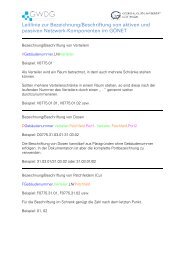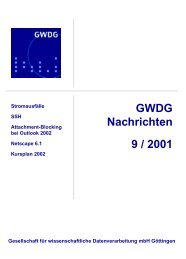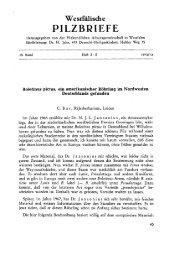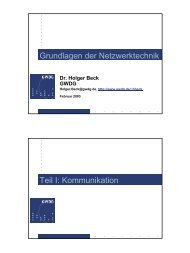Forschung und wissenschaftliches Rechnen - Beiträge zum - GWDG
Forschung und wissenschaftliches Rechnen - Beiträge zum - GWDG
Forschung und wissenschaftliches Rechnen - Beiträge zum - GWDG
Sie wollen auch ein ePaper? Erhöhen Sie die Reichweite Ihrer Titel.
YUMPU macht aus Druck-PDFs automatisch weboptimierte ePaper, die Google liebt.
While this naturally requires more complicated algorithms, it turns out by<br />
work of Pachter and Sturmfels that methods from polyhedral geometry and<br />
polymake, in particular, can be employed. This approach is comprehensively<br />
covered in the book [19].<br />
7 Software Design<br />
Since its first version from 1997 polymake was —at least partially— rewritten<br />
several times. In spite of the many changes on the way, the core ideas<br />
always remained the same. The first goal was to have a flexible interface<br />
structure such that it is possible to interface to as many existing polytope processing<br />
software components (developed by other people) as possible. The<br />
second goal was scalability in the sense that the system should be useful both<br />
for programmers and mere users, and also both for students and expert scientists.<br />
Feeling that one language is not enough for this, this resulted in an objectoriented<br />
hybrid design based on the two programming languages C++ and<br />
Perl. The borderline is roughly defined as follows: The Perl side takes<br />
care of all the object management and their interfaces, while the C++ half<br />
harbors the mathematical algorithms. Information exchange between both<br />
worlds is subject to a client-server scheme, Perl being the language of the<br />
server.<br />
Convex polytopes are represented in the system as a class of objects which<br />
are defined by an extendible list of properties. In the current distributed version<br />
there are already more than one h<strong>und</strong>red of these properties defined; they<br />
range from the vertices (VERTICES) and facets (FACETS) of a polytope to<br />
the list of Steiner points on all the faces (STEINER_POINTS) and the information<br />
whether or not the polytope is SIMPLICIAL or CUBICAL.<br />
The client perspective (on the C++ side) is very restricted: The client asks<br />
the server for properties of some polytope object and leaves it entirely to<br />
the server to decide how these should be obtained. The Perl-written server<br />
has a list of rules which specify how to compute properties from the already<br />
known ones. For instance, there is a rule which explains how the facets can<br />
be computed for a polytope which was initially specified as the convex hull<br />
of finitely many points; that is, there is a convex-hull algorithm rule which<br />
computes FACETS from POINTS. Actually, as in this case it is the fact, there<br />
may be several competing rules computing the same. It is the task of the<br />
server to compile admissible sequences of rules (via a Dijkstra type algorithm<br />
for determining shortest weighted paths) to fulfill the user’s (or the client’s)<br />
requests from the information initially given.<br />
It is f<strong>und</strong>amental to the design that the set of rules as well as the list of<br />
properties known to the system can be expanded and modified. Moreover, the<br />
50
















